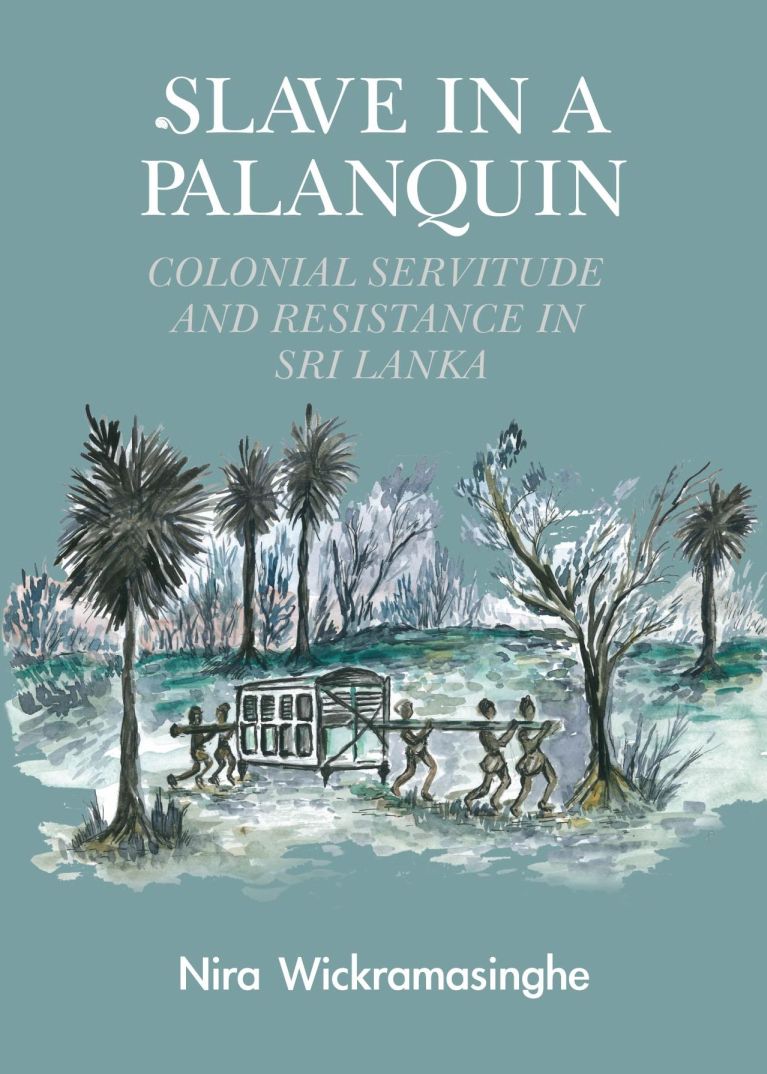Slave in a Palanquin
Book Review by Tyron Devotta
Nira Wickramasinghe’s latest book is a powerful expose of the slave trade in colonial Ceylon. Her work is well-researched, which will be of academic value; it is also an interesting read as it’s not just cold facts that she presents but also pulls out characters from an abyss of misery with their own stories to tell.
Historians come with various hats, but generally broken down into two primary groups, the ones who depend on hearsay and imagination and those who stick to proper research and proof! Wickramasinghe falls into the latter category.
Local braided in Global
She is a woman with a mission, she says her book “is about unveiling, finding the shadows and the contours left by the absence of enslaved people as well as removing the disguises put there to take us down paths that lead away from the ghosts, towards statues erected by states and dominant groups.” In her introduction she says “this book (Slave in a Palanquin) aims to understand the practices of becoming and being of enslaved people in a local context that was braided with the global”.
Portuguese, Dutch and British
It covers the territories that were conquered by the Portuguese in the 16th century and in the 17th and 18th century by the Dutch East India Company (VOC) and finally during the time of the British from 1796. She says our island was on the crossroads of slavery and disputes the beliefs that Sri Lanka was particularly connected to Kaffir slaves, which was limited to a few possessions of Dutch proprietors. Wickramasinghe also dismisses what Brohier (Dutch Burgher author) says about a Kaffir insurrection and digs deep into this story of Slave Island in Colombo, laying out an entirely new narrative which may require some re-writing of our present day tourist brochures.
Historic Crevices
History writers have to be forensic detectives, and this one examines various crime scenes to uncover fresh evidence. The previously painted rosy pictures of our colonial masters have been tarred with an investigative brush, which has gone deep into historic crevices.
When the British took control of the Southern Maritime Provinces of Ceylon, they inherited a society of subjects bestowed with different degrees of freedom and autonomy from their predecessors — the Portuguese and the Dutch traded in humans across the Indian Ocean. Wickramasinghe says in the VOC held territories it was customary not to enslave the indigenous population but to bring slaves from elsewhere. The Northern Province in Sri Lanka was an exception to this rule. She also points to the fact that most of the slaveholders in Colombo in the first decade of the 19th century were of Dutch descent or burghers!
Indigenous Fault Lines
In the island's south, slaves were not only limited to the colonisers but indigenous people also enslaved men and women. Slaves during that time were treated like movable property to be passed onto inheritors' land, jewelry, and household items.
In a chapter entirely dedicated to slavery in Jaffna, she says that slavery was inbuilt to the caste system and during the Dutch rule by sanctioning and tapping into perceived local practices of slavery, colonial rulers constructed and legally made up a whole slave caste. The Dutch made large profits through the export trade, which was in reality a slave based economy in which the peninsula produced palmyra products as well onions,chillies, turmeric, pumpkins and eggplants in addition to tobacco. She says that the Dutch profited from this trade and made no attempt to curtail the social abuse it encouraged.
It is interesting to note that in her research she finds that the Thesawalamai (Jaffna customary law) was drawn up by the Dutch administrator, who wrote down the customs after gaining practical knowledge in the courts of Jaffna and also by insights given by the Vellalar chiefs. Their system of governance was that of a divided rule where they made the upper-class people collectors of revenue or mudaliars. The newly written Thesawalamai code by the Dutch which dealt with inheritance, and transfer of property had explicit references to slaves and the slave trade.
Change and Reform
All this changed when the British came. Slavery was abolished by 1833 by the British parliament and by 1844, it ended in Ceylon. Whilst many reforms happened to enslaved people, during the time of the last coloniser, Nira Wickramasinghe’s investigation goes into a particular formula employed by the British to free the enslaved castes of Jaffna. In her chapter titled the “Chilaw experiment”, she explained how these castes were brought to the south-western part of the island in the early decades of British rule to perform hard labour on canals and other public works. The carrot that was offered was that on their return, their status would change in Jaffna’s hierarchical society. A promise that was not fully realised!
Engaged History
A historical piece written especially by a modern day author has to be tested for its biases. Is the writer trying to place the values, beliefs, behaviors, and attitudes of the present into their findings and generate opinion? Or is the historian trying to understand research in the context of how and why people of that era thought and behaved!
Nira Wickramasinghe says her book is a “engaged history of the present.” Her investigation is directed towards exposing the wrong of slavery and offers no excuses for such practices. But thankfully it is not a rant, and so we can see the objectivity of the writer in proving her point, which is refreshing. An excellent piece, definitely worth a place on your shelf if you are a historophile!


